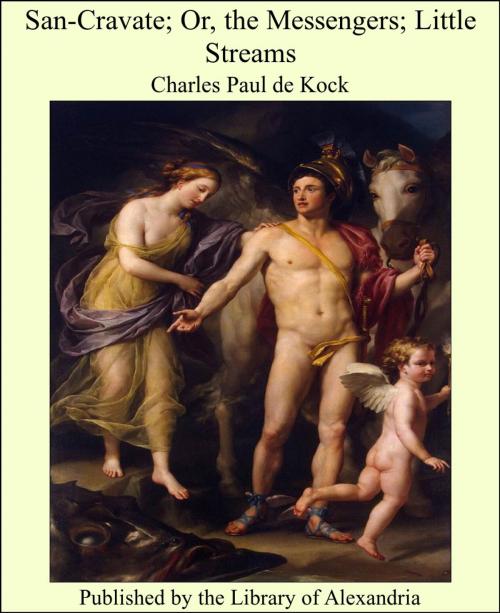San-Cravate; Or, the Messengers; Little Streams
Nonfiction, Religion & Spirituality, New Age, History, Fiction & Literature| Author: | Charles Paul de Kock | ISBN: | 9781465529138 |
| Publisher: | Library of Alexandria | Publication: | March 8, 2015 |
| Imprint: | Language: | English |
| Author: | Charles Paul de Kock |
| ISBN: | 9781465529138 |
| Publisher: | Library of Alexandria |
| Publication: | March 8, 2015 |
| Imprint: | |
| Language: | English |
THE IDLERS.—BOULEVARD DES ITALIENS Three young men, arm in arm, were walking, or, to speak more accurately, loitering, along Boulevard des Italiens, looking to right and left, scrutinizing the women at close quarters, especially when they were pretty; commenting aloud on the face of one and the bearing of another, interspersing their reflections with jests, puns, foolish remarks, and bursts of laughter; and, lastly, smoking cigars, an accomplishment which is now indispensable to the young men of fashion whose ordinary promenade is the Boulevard de la Chaussée d'Antin. It is a little world in itself that frequents Boulevard des Italiens, a fashionable, aristocratic, eccentric boulevard, where, none the less, many of the promenaders affect manners, dress, and language which remind us forcibly of Diogenes. Each portion of a large city has its quarters, with their habitués and their residents, whose dress, language, and manners have their own peculiar characteristics. Thus, there is a marked difference between the costume of an annuitant of the Marais and that of the ex-young man of the Chaussée d'Antin; between the dress of a grande dame of Faubourg Saint-Germain and that of a bourgeois housewife of the Cité; between the grisette of Rue Saint-Jacques and her of Place Bréda, who has lately taken the name of lorette. Of course, the residents of one quarter do not remain altogether on their own territory, and they may sometimes be met with in a neighboring section. But, even then, a practised eye never makes a mistake; it recognizes the strangers at once, and does not confound them with the natives of the quarter. In vain do the former try to assume the bearing and manners of the latter—the natural instincts, when we try to drive them away, return at a gallop, and it would be as difficult for a government clerk who lives on Rue Saint-Antoine to resemble a clerk in a banking house on Rue Laffite, as for a siren of Place Maubert to copy the manners of a young lady of Faubourg Saint-Honoré. Boulevard des Italiens is no ordinary promenade; it deserves the attention of the observer; indeed, it is worthy of a chapter in the history of Paris, for it has changed its name more than once in accordance with political exigencies. At the time of the Revolution of '89, this segment of the boulevards was called Coblentz, and it retained that name under the Empire. Not until 1815, at the time of the Second Restoration, did it exchange the name of Coblentz for that of Gand. The former name recalled the place of rendezvous of the émigrés of the Revolution; the Other, the second return of Louis XVIII. The French have always loved to bring politics into the most trivial things; they have brought it into their ballads and into the names of flowers; so they could consistently give a political tinge to the name of a fashionable promenade. But the great majority of the ladies who resort to Boulevard des Italiens in search of conquests put no politics in their smiles; they are cosmopolites, for they have been known to dart glances impartially at republicans and legitimists, at old soldiers of the Empire and favorites of the Restoration; it has been observed, however, that they affect more particularly the partisans of the juste-milieu
THE IDLERS.—BOULEVARD DES ITALIENS Three young men, arm in arm, were walking, or, to speak more accurately, loitering, along Boulevard des Italiens, looking to right and left, scrutinizing the women at close quarters, especially when they were pretty; commenting aloud on the face of one and the bearing of another, interspersing their reflections with jests, puns, foolish remarks, and bursts of laughter; and, lastly, smoking cigars, an accomplishment which is now indispensable to the young men of fashion whose ordinary promenade is the Boulevard de la Chaussée d'Antin. It is a little world in itself that frequents Boulevard des Italiens, a fashionable, aristocratic, eccentric boulevard, where, none the less, many of the promenaders affect manners, dress, and language which remind us forcibly of Diogenes. Each portion of a large city has its quarters, with their habitués and their residents, whose dress, language, and manners have their own peculiar characteristics. Thus, there is a marked difference between the costume of an annuitant of the Marais and that of the ex-young man of the Chaussée d'Antin; between the dress of a grande dame of Faubourg Saint-Germain and that of a bourgeois housewife of the Cité; between the grisette of Rue Saint-Jacques and her of Place Bréda, who has lately taken the name of lorette. Of course, the residents of one quarter do not remain altogether on their own territory, and they may sometimes be met with in a neighboring section. But, even then, a practised eye never makes a mistake; it recognizes the strangers at once, and does not confound them with the natives of the quarter. In vain do the former try to assume the bearing and manners of the latter—the natural instincts, when we try to drive them away, return at a gallop, and it would be as difficult for a government clerk who lives on Rue Saint-Antoine to resemble a clerk in a banking house on Rue Laffite, as for a siren of Place Maubert to copy the manners of a young lady of Faubourg Saint-Honoré. Boulevard des Italiens is no ordinary promenade; it deserves the attention of the observer; indeed, it is worthy of a chapter in the history of Paris, for it has changed its name more than once in accordance with political exigencies. At the time of the Revolution of '89, this segment of the boulevards was called Coblentz, and it retained that name under the Empire. Not until 1815, at the time of the Second Restoration, did it exchange the name of Coblentz for that of Gand. The former name recalled the place of rendezvous of the émigrés of the Revolution; the Other, the second return of Louis XVIII. The French have always loved to bring politics into the most trivial things; they have brought it into their ballads and into the names of flowers; so they could consistently give a political tinge to the name of a fashionable promenade. But the great majority of the ladies who resort to Boulevard des Italiens in search of conquests put no politics in their smiles; they are cosmopolites, for they have been known to dart glances impartially at republicans and legitimists, at old soldiers of the Empire and favorites of the Restoration; it has been observed, however, that they affect more particularly the partisans of the juste-milieu















